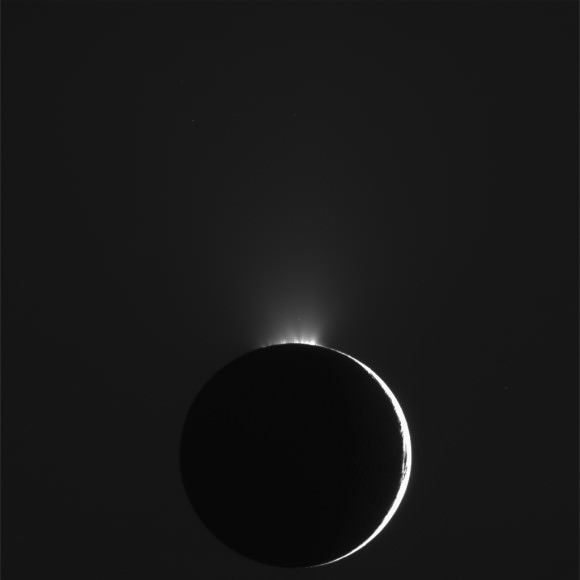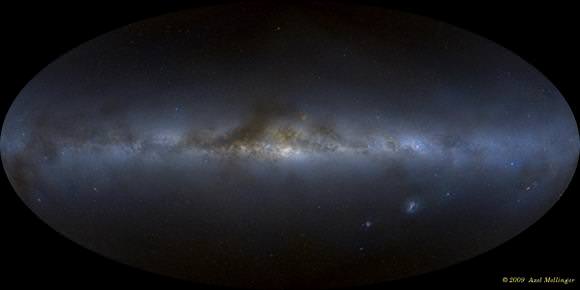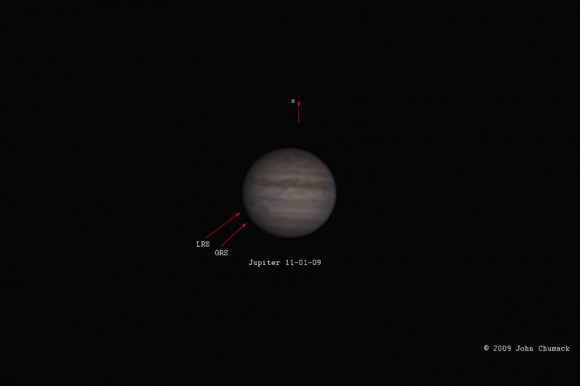This Week's WITU Challenge
Here's this week's image for the WITU Challenge, to test your visual knowledge of the cosmos. You know what to do: take a look at this image and see if you can determine where in the universe this image is from; give yourself extra points if you can name the spacecraft responsible for the image. We’ll provide the image today, but won’t reveal the answer until tomorrow. This gives you a chance to mull over the image and provide your answer/guess in the comment section. Please, no links or extensive explanations of what you think this is — give everyone the chance to guess.
(...)
Read the rest of This Week's WITU Challenge (0 words)
NASA May Drop Ares I-Y Test Flight
Just one week after the first test flight test of the Ares I-X rocket, NASA says it may decide to cancel a follow-up launch called Ares 1-Y, which wasn't scheduled until 2014. Reportedly, program managers recommended dropping the flight because, currently, there isn't the funding to get an upper stage engine ready in time. The test flight may be replaced with a new, still undefined test flight in 2012 or 2013. “It simply does not fit where we are headed,” said Jeff Hanley, Constellation Program manager was quoted in NASA's Constellation Blog. “The test vehicle was intended to meet evolving needs but the current configuration is too different from what the program requires to certify the Ares/Orion vehicle systems.”
(...)
Read the rest of NASA May Drop Ares I-Y Test Flight (258 words)
Do "Skeleton" Filaments Give Structure to the Universe?
This 3D illustration shows the position of the galaxies and reveals the extent of this gigantic structure. The galaxies located in the newly discovered structure are shown in red. Galaxies that are either in front or behind the structure are shown in blue. Credit: ESO
Are there "skeletons" out in the Universe –structures that form the framework of how galaxies are distributed? Astronomers have tracked down a gigantic, previously unknown assembly of galaxies located almost seven billion light-years away from us, which seems to point to a prominent galaxy structure in the distant Universe, providing further insight into the cosmic web and how it formed. “Matter is not distributed uniformly in the Universe,” says Masayuki Tanaka from ESO, who led the new study. “In our cosmic vicinity, stars form in galaxies and galaxies usually form groups and clusters of galaxies. The most widely accepted cosmological theories predict that matter also clumps on a larger scale in the so-called ‘cosmic web’, in which galaxies, embedded in filaments stretching between voids, create a gigantic wispy structure.”
(...)
Read the rest of Do "Skeleton" Filaments Give Structure to the Universe? (409 words)
Hints of More Extra-Galactic Planets
We regularly report on the discovery of extrasolar planets in our galaxy, but earlier this year came news of possibly the first planet discovered outside of the Milky Way. Now comes news of the potential discovery of dozens of extragalactic planetary systems. Erin Mentuch and her colleagues at the University of Toronto in Canada have analyzed 88 remote galaxies and found a broad continuum excess in the near-infrared. They conclude the most likely explanation for the 2-5 micron excess is the light from circumstellar disks, or young solar systems, forming around massive young stars. "[This] presents us with an exciting opportunity to measure the formation rate of planetary systems at cosmic epochs before our own Solar System formed," the team writes in their paper.
(...)
Read the rest of Hints of More Extra-Galactic Planets (160 words)
NASA Science News for November 3, 2009
The MESSENGER spacecraft's third flyby of the planet Mercury has given scientists, for the first time, an almost complete view of the planet's surface and revealed some dramatic changes in Mercury's comet-like tail.
FULL STORY at
http://science.nasa.gov/headlines/y2009/03nov_hiddenterritory.htm?list1035898
Solving the Mystery of Cosmic Rays' Origins

What accelerates cosmic rays to nearly the speed of light? Astronomer have pondered that question for nearly 100 years, and now new evidence supports a theory held for two decades that cosmic rays likely are powered by exploding stars and stellar winds. "This discovery has been predicted for almost 20 years, but until now no instrument was sensitive enough to see it," said Wystan Benbow, an astrophysicist at the Smithsonian Astrophysical Observatory who coordinated this project for the Very Energetic Radiation Imaging Telescope Array System (VERITAS) collaboration.
(...)
Read the rest of Solving the Mystery of Cosmic Rays' Origins (624 words)
Jupiter's Dueling Red Spots
Even though most of us have been suffering from poor seeing conditions due to both hemisphere's seasonal climate changes, the changes we're experiencing look like nothing compared to what's happening on Jupiter. If you think we've got turbulent atmosphere and more than our fair share of clouds – then check out what John Chumack's been watching! (...)
Read the rest of Jupiter's Dueling Red Spots (625 words)
Fabulous! Enceladus Raw Flyby Images

Carolyn Porco, the lead for Cassini's imaging team, warned on Twitter that the flyby of Saturn's moon Enceladus performed by the spacecraft on Nov. 2 wasn't really an "imaging" flyby, and that we might have to wait until the Nov. 21 flyby for really good images. But just take a look the images returned so far, with stunning looks at the jets shooting from the moon! Another image takes a close look at the surface. These are raw, unprocessed images, but what images they are! This is the second image from today's flyby returned by the spacecraft. See below for more.
(...)
Read the rest of Fabulous! Enceladus Raw Flyby Images (201 words)
1 Milky Way; 3,000 Images

What a gorgeous and immense image! And it's full of stars! An astronomer from Central Michigan University has put together a new high-resolution panoramic image of the full night sky , with the Milky Way galaxy as its centerpiece. Axel Mellinger stitched together over 3,000 images to create this beautiful image, which also comes in an interactive version, showing stars 1,000 times fainter than the human eye can see, as well as hundreds of galaxies, star clusters and nebulae.
(...)
Read the rest of 1 Milky Way; 3,000 Images (254 words)
NASA Science News for October 30, 2009
NASA's next Mars rover, a super-capable robot named "Curiosity," will push Mars exploration to a new level.
FULL STORY at
http://science.nasa.gov/headlines/y2009/30oct_curiosity.htm?list1035898
Volunteers Still Needed for Simulated Mars Mission

Need to get away from it all? If you have a background in medicine, computers or engineering and can speak a little Russian and English, this might be just what you are looking for. The European Space Agency and the Russian Institute of Medical and Biological Problems are still looking for volunteers to participate in a 520-day simulation of an expedition to Mars. The institute announced last week the opening of registration, but haven't yet gotten enough applicants. The nearly two-year experiment will simulate all aspects of a journey to the Red Planet, with a 250-day outward trip, a 30-day stay on its surface, and a 240-day return flight.
(...)
Read the rest of Volunteers Still Needed for Simulated Mars Mission (282 words)
Einstein Still Rules, Says Fermi Telescope Team
While the Fermi Space Telescope has mapped the gamma ray sky with unprecedented resolution and sensitivity, it now has been able to take a measurement that has provided rare experimental evidence about the very structure of space and time, unified as space-time. Einstein's theory of relativity states that all electromagnetic radiation travels through a vacuum at the same speed. Fermi detected two gamma ray photons which varied widely in energy; yet even after traveling 7 billion years, the two different photons arrived almost simultaneously.
(...)
Read the rest of Einstein Still Rules, Says Fermi Telescope Team (378 words)
Supernova 2009js… Another One Bites The Dust!
Far away in the constellation of Aries, in a 14th magnitude barred spiral galaxy designated as NGC 918… a star exploded with enough candlepower to briefly outshine its home. Discovered independently by Lick Observatory Supernova Search (LOSS) and Koichi Itagaki (Japan) on October 11, 2009, this Type II supernova might be hiding in the intergalactic dust, but it isn't hiding from Joe Brimacombe. (...)
Read the rest of Supernova 2009js… Another One Bites The Dust! (610 words)
Free NASA iPhone App
NASA announced last week they had developed the first iPhone application geared specifically for keeping track of all things NASA. I don't have an iPhone, so I didn't look into it, but the iPhone users I know seem to be very excited about it. So here's all the info you should need to hook up with NASA via your iPhone:
The NASA App is available free of charge on the App Store from Apple directly to the iPhone and iPod Touch or within iTunes.
What does it do?
(...)
Read the rest of Free NASA iPhone App (146 words)
Exploring With an Armada of Autonomous Robots
JPL has a fun article on their website detailing what future robotic exploration might entail: an armada of robots could one day fly above the mountain tops of Saturn's moon Titan, cross its vast dunes and sail in its liquid lakes. This is the vision of Wolfgang Fink, from the California Institute of Technology. He says we are on the brink of a great paradigm shift in planetary exploration, and the next round of robotic explorers will be nothing like what we see today.
(...)
Read the rest of Exploring With an Armada of Autonomous Robots (592 words)








